If you own a swimming pool, keeping your water clean and safe is probably always on your mind. Shocking your pool with liquid chlorine is one of the fastest and most effective ways to destroy algae, bacteria, and other nasty stuff you don’t want floating around.
To shock your pool using liquid chlorine, just measure the right amount, pour it evenly around the pool, and let your pump do the heavy lifting.

Using liquid chlorine is pretty straightforward and can really change up your pool care routine. Whether you’re fighting cloudy water, dealing with a busy swim day, or just opening the pool for summer, learning how to shock your pool is a must for any pool owner who wants to feel on top of things.
Understanding Liquid Chlorine and Pool Shock
When you want to shock your pool, it helps to actually know what liquid chlorine is, how it works, and the different types of pool shock you could use. Getting a handle on these basics just makes pool care less of a headache.
What Is Liquid Chlorine?
Liquid chlorine is a strong, unstabilized form of chlorine that a lot of pool folks rely on. Usually, it’s a clear liquid with 10-12.5% available chlorine—pretty potent stuff.
People like it because it acts fast and mixes into the water easily. No need to mess with dissolving powder or granules, just pour it straight in.
This chlorine is unstabilized, so it doesn’t have cyanuric acid. Sunlight breaks it down quicker than stabilized types, but that’s actually perfect for shock treatments when you need a quick boost to your chlorine level.
You’ll usually find liquid chlorine in big jugs at pool stores. It’s less risky to handle than some powders, but still—don’t skip the gloves and try not to spill.
How Liquid Chlorine Works in Pools
Liquid chlorine bumps up your free chlorine level fast. When you shock the pool, you’re basically hitting the reset button by wiping out bacteria, algae, and organic gunk.
It releases hypochlorous acid, which is the main germ-killer and contaminant destroyer. Because it’s a liquid, it spreads out almost instantly, so you get an even chlorine kick everywhere.
Using liquid shock regularly keeps your pool water healthy and clear. It doesn’t dump extra stabilizer, calcium, or weird byproducts into your water, either.
Liquid chlorine really shines right before or after heavy pool use, or if the water looks cloudy or you spot algae. After shocking, wait for the chlorine to drop to a safe level before anyone jumps in.
Types of Pool Shock Treatments
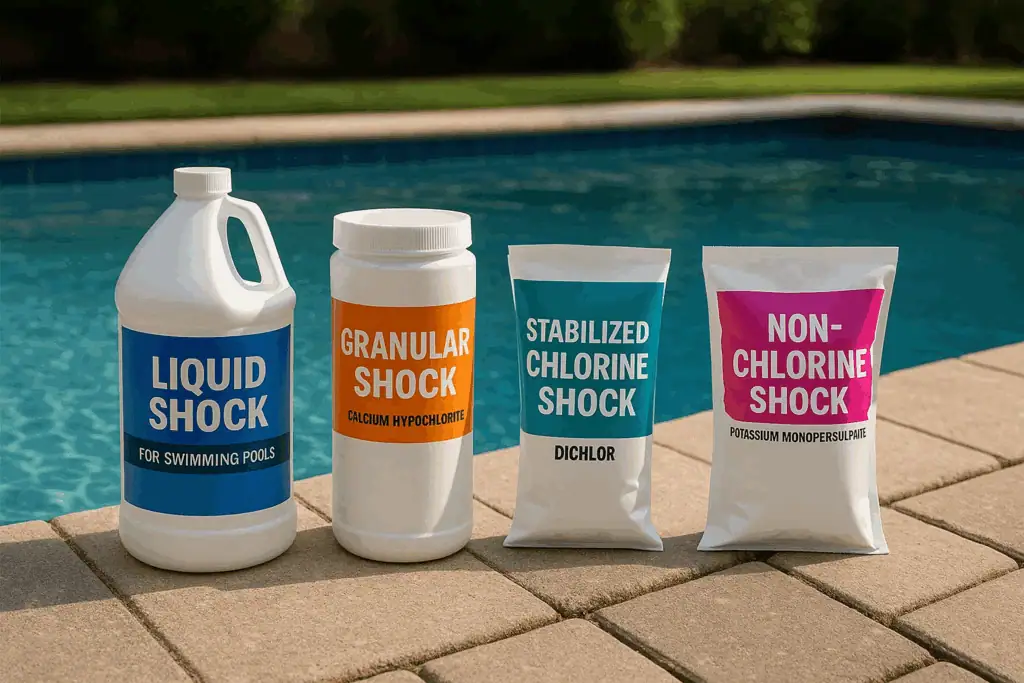
Pool shock isn’t one-size-fits-all—there are a few types, and each has its own perks. The main ones:
- Liquid shock (liquid chlorine): Unstabilized, quick-acting, solid for regular or tough shock jobs.
- Granular shock (calcium hypochlorite): Granules or powder, usually stronger but you have to dissolve it first.
- Stabilized chlorine shock (dichlor): Has cyanuric acid, so it holds up in sunlight, but can raise stabilizer over time.
- Non-chlorine shock (potassium monopersulfate): No chlorine here. Handy if you want to shock and swim soon after.
Here’s a quick table for reference:
| Shock Type | Chlorine Content | Stabilized | Form |
|---|---|---|---|
| Liquid Chlorine | High | No | Liquid |
| Granular Cal Hypo | Very High | No | Granular |
| Dichlor Shock | High | Yes | Granular |
| Non-Chlorine Shock | None | N/A | Granular |
Just pick what matches your pool’s needs and your own preferences. Both liquid and granular chlorine can get the job done, but how you use them changes how fast and how well your pool gets cleaned up.
How To Calculate the Right Amount of Liquid Chlorine
Getting the amount of liquid chlorine right is key if you want a safe, clear pool. You’ll need to know your pool’s volume, your target chlorine level (in ppm), and do a bit of math to figure out how much to pour in.
Measuring Pool Volume for Accurate Dosage
First, figure out how much water your pool holds. Pool volume totally changes how much chlorine you’ll need each time you shock.
For rectangular pools, multiply length × width × average depth (in feet), then multiply by 7.5 to get gallons.
Example:
16 ft x 32 ft x 4 ft (average depth) x 7.5 = 15,360 gallons
For round pools, measure the diameter, then use:
Diameter × Diameter × Average Depth × 5.9 = Gallons
If you’re unsure, just use an online pool calculator. Getting this right means your chlorine dose will actually work.
Or even easier, just use our handy calculator:
Pool Volume Calculator
Please enter your pool shape and dimensions:
Determining Chlorine Levels (PPM) Needed
Chlorine for shocking is often measured in ppm (parts per million) although many test strips show the level in mg/l (milligrams per liter) but both are basically the same. Most pool folks say to bump free chlorine up to 10–20 ppm when shocking. That’ll knock out bacteria, algae, and combined chlorine.
Test your water using strips or a kit. Write down your current free chlorine and total chlorine.
The difference between total and free chlorine is “combined chlorine.”
Combined chlorine = Total chlorine – Free chlorine
If combined chlorine is over 0.5 ppm, it’s time to shock. The goal is to raise free chlorine by at least 10 times your combined chlorine value.
How Much Liquid Chlorine to Add
Use this handy calculator to work out how much liquid chlorine (or other types of chlorine) to add.
Pool Chlorine Calculator
Proper Method for Adding Liquid Chlorine to Shock Your Pool
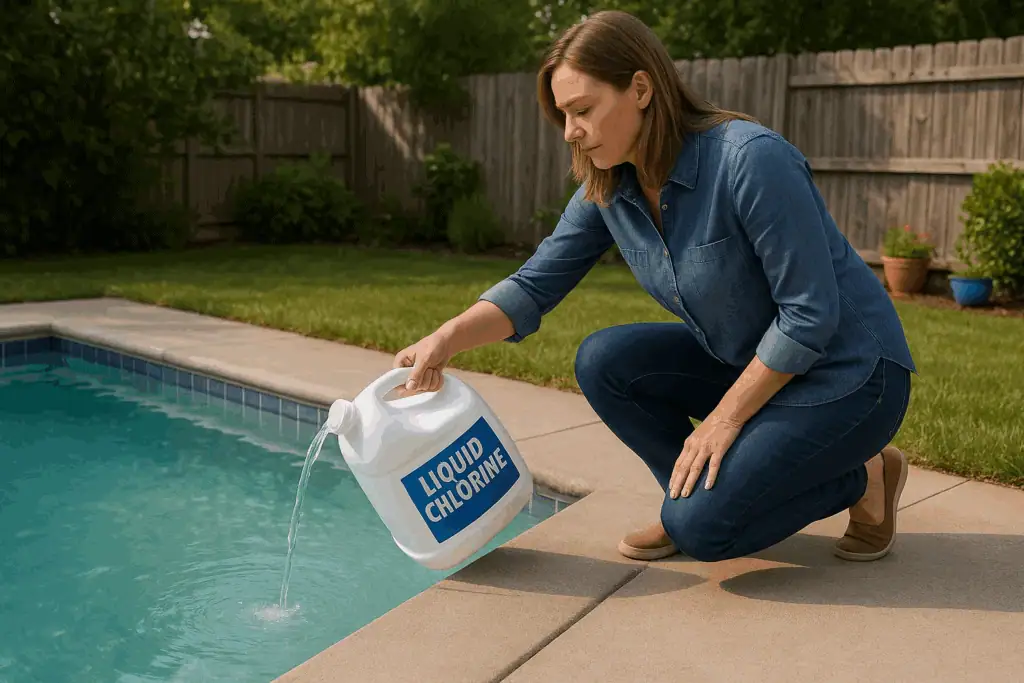
When you shock your pool with liquid chlorine, you’ll want to prep the water, add the right amount of chlorine to your pool evenly, and keep the pool pump running to mix everything well. These steps really help keep your pool water clean and safe for swimming.
Ideally, shock your pool in the evening and then let the pool pump run all night to circulate the water and chlorine. Sunlight degrades unstabalized chlorine quickly which is who doing it after sunset works better than in the morning.
Preparing the Pool for Shock
Start by testing your pool water for chlorine and pH. Aim for a pH between 7.2 and 7.4 so the chlorine works best. If your numbers are off, fix the pH before you shock.
Scoop out leaves, bugs, or whatever else is floating around with a skimmer net. The cleaner your pool, the more your chlorine can focus on the real threats, not just decaying leaves.
Turn on your pool pump before you add any chemicals. Shocking at night or in the evening is best—sunlight eats up chlorine fast. Wait until the water is still but circulating, so the liquid chlorine mixes in without a hitch.
Steps to Add Liquid Chlorine Directly to the Pool
Double-check your pool’s volume so you know how much shock to use. For most pools, 1 gallon of 10% liquid chlorine treats 10,000 gallons and bumps free chlorine by about 10 ppm. Adjust for your pool size as needed.
Wear gloves and eye protection—seriously, don’t skip this part. Open the chlorine, and walk around the pool edge as you pour it straight into the water. Try to pour it evenly for the best coverage.
Don’t just dump it all in one spot—that can create hot spots and leave other areas low. Always add it while the pump is running to help things mix fast.
Circulating and Mixing the Chlorine
Let your pool pump run for at least 8 hours after adding chlorine. That steady flow helps spread the shock throughout the pool, so your chlorine level stays consistent everywhere.
If you’ve got a pool vacuum or a robotic cleaner, run it after shocking to stir up any spots where chlorine might’ve settled. After a few hours, check the water again—chlorine should be in the safe range, between 1 and 3 ppm, before anyone hops in.
Don’t swim until the chlorine level is back down to a safe range. Good circulation and a little patience let the chlorine do its job—cleaning the water and keeping your pool safe for everyone.
When and Why You Should Shock Your Pool
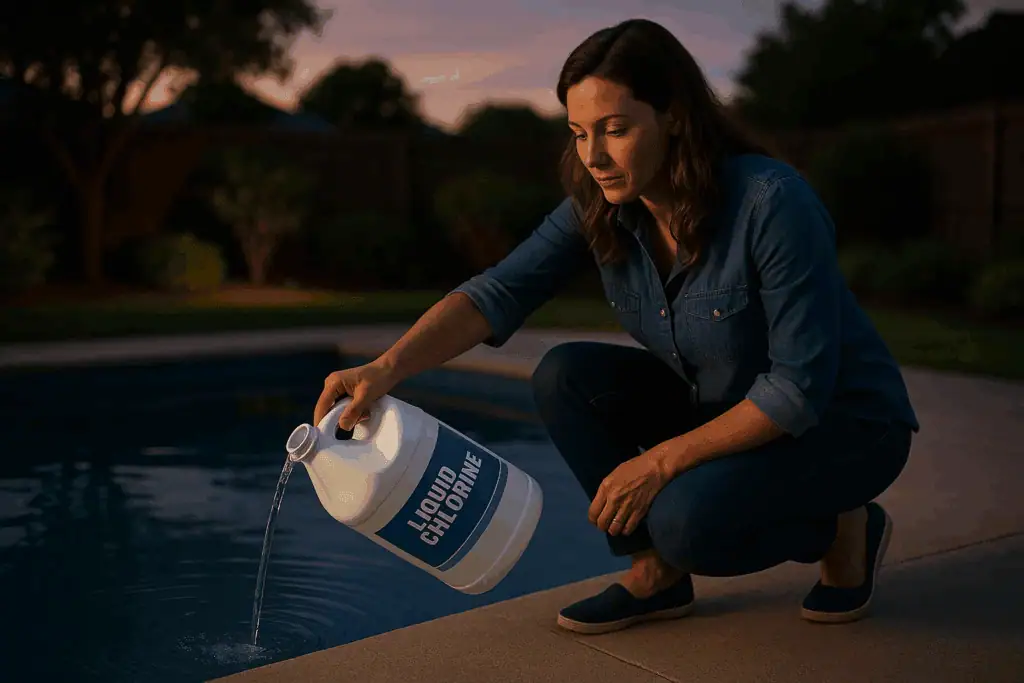
Keeping a chlorinated pool clean takes more than just skimming leaves or running the pump. If you shock your pool at the right moments, you can control bacteria and algae, and keep the water safe for swimming.
Common Reasons to Shock a Pool
After a big pool party or a storm that dumps debris in the water, you’ll probably need to shock your pool. More swimmers mean more sweat, sunscreen, and, let’s be real, probably a little urine—these all boost contaminants and push up your combined chlorine levels.
That classic “chlorine smell”? It’s not actually from too much chlorine—it’s from chloramines, which pop up when your sanitizer is getting overwhelmed. If you catch that odor, your pool’s asking for a shock.
Cloudy water and algae blooms are other big reasons. If you notice your chlorine reading is low or your pool starts looking greenish, a shock treatment can get things back on track. Regular shocks help keep your free chlorine steady and the water clear.
| Reason | Why Shock? |
|---|---|
| Heavy use | Removes sweat, sunscreen |
| Storm or debris | Clears organics, dirt |
| Chlorine odor | Removes combined chlorine |
| Algae or cloudy | Kills germs/alga, clears water |
Signs Your Pool Needs Shock Treatment
Keep an eye out for warning signs. If you spot green, yellow, or black algae, it’s time to shock. Cloudy water is another red flag.
Test your chlorine regularly. If free chlorine drops below 1-3 ppm but total chlorine stays high, combined chlorine is creeping up—your sanitizer isn’t keeping up with the gunk in the water.
Notice a strong chlorine smell? That’s usually chloramines, which you’ll need to get rid of with a shock. If your eyes or skin start feeling extra irritated after a swim, go ahead and test, and don’t hesitate to shock if needed.
Best Practices for Maintaining Safe and Effective Pool Chlorine Levels
Chlorine is what keeps pool water clear and safe. If you get in the habit of testing, understand what affects your chlorine, and know when to shock, pool care gets a whole lot easier.
Testing Chlorine Levels After Shocking
After you shock your pool, grab a test kit and check both free and total chlorine. You want free chlorine to land somewhere between 1-3 ppm before anyone hops in.
Don’t jump in right after shocking. Wait until the chlorine drops back into the safe range—usually takes about 8 hours, sometimes overnight.
Honestly, it’s easy to forget about things like pH and cyanuric acid, but they matter for how well your chlorine works. Testing every few days keeps your pool healthy and looking good.
Factors Affecting Chlorine Effectiveness
Chlorine isn’t a one-size-fits-all deal. Sunlight, heavy swimming, rain, and even your pool type (plaster, vinyl, or saltwater) all play a part in how much chlorine you’ll need.
Got an outdoor pool? The sun’s UV rays chew through chlorine fast. Cyanuric acid, or pool stabilizer, helps protect against that. If you’re low on stabilizer, your chlorine just won’t stick around.
Stuff like leaves, dirt, and swimmer sweat eats up chlorine too. If your pool gets a lot of use or collects debris, you’ll probably need to tweak your chlorine more often.
How Often Should You Shock Your Pool?
Most folks shock their pool once a week during swim season, but honestly, it depends. Heavy use, lots of rain, or scorching weather might mean you need to shock more often.
If your chlorine reading dips or the water gets cloudy, shock it—doesn’t matter if it’s a saltwater or regular chlorine pool. This clears out contaminants and resets the water.
Some people like to pick a day—say, every Sunday—for shocking. Whatever works, just remember to test the water after each shock so you know it’s safe to swim.
Frequently Asked Questions
Shocking with liquid chlorine clears up algae, cloudy water, and bacteria. If you know how much to use and follow the steps, it’s pretty straightforward and effective.
What are the steps for properly shocking a pool with liquid chlorine?
Start by testing your pool water so you know your chlorine level. Figure out how much you’ll need for your pool size.
Slowly pour the chlorine around the pool’s edges. Run the pump for at least 8 hours so it circulates well. Hold off on swimming until chlorine levels drop below 3 ppm.
How much liquid chlorine is required to shock a typical 15,000-gallon pool?
Usually, you’ll need about 1 gallon of 12.5% liquid chlorine for every 10,000 gallons. So for a 15,000-gallon pool, start with 1.5 gallons.
If there’s algae, you might have to use more. Always double-check the label on your chlorine for exact directions.
Can you pour liquid chlorine directly into a pool for shocking, or is there a specific method?
Yep, you can pour it right in, but go slow and walk around the edges. That spreads it out and helps avoid damaging the liner or surface.
Don’t dump it all in one spot. Keep the filter and pump running so it mixes in completely.
What amount of liquid chlorine should I use for shock treatment when dealing with pool algae?
If you’re fighting algae, double up on the shock dose. For 15,000 gallons, that’s about 3 gallons of 12.5% chlorine in liquid form.
Give the pool walls and floor a good brushing before and after you add the chlorine. Keep the pump running constantly until the water clears up.
When dealing with a green pool, how should I go about the shocking process?
First, check and balance your pool’s pH—shoot for around 7.2 before shocking. Brush off as much algae as you can, then hit it with a heavy shock dose.
For a green 15,000-gallon pool, use about 3 gallons. Run the filter nonstop and keep brushing until things look clear again.
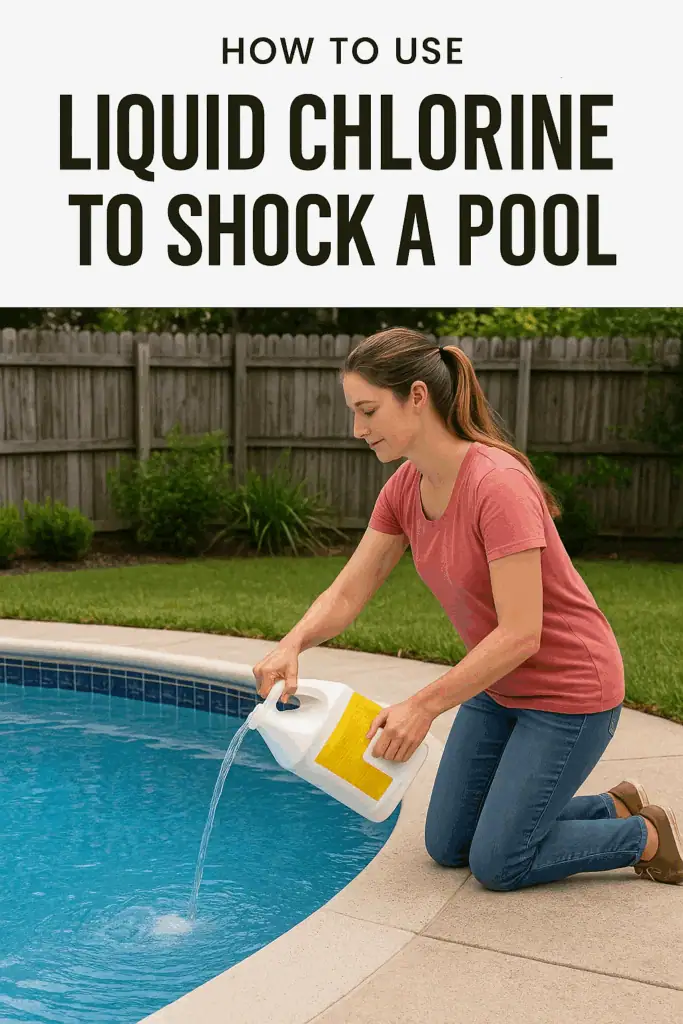
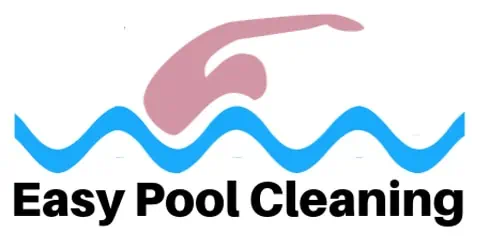
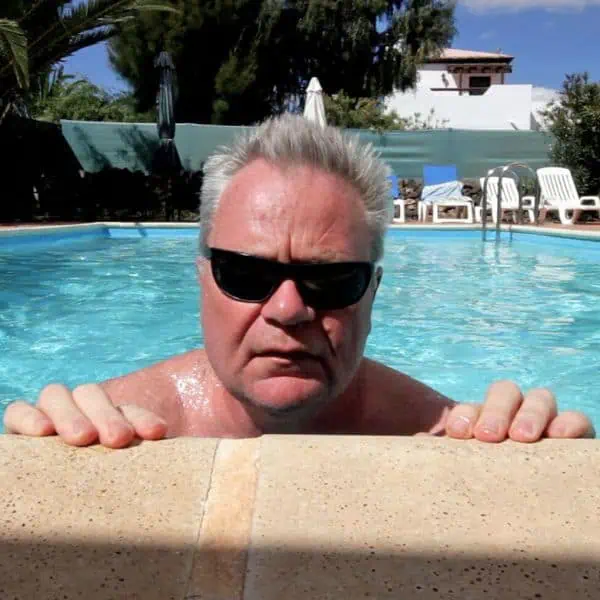


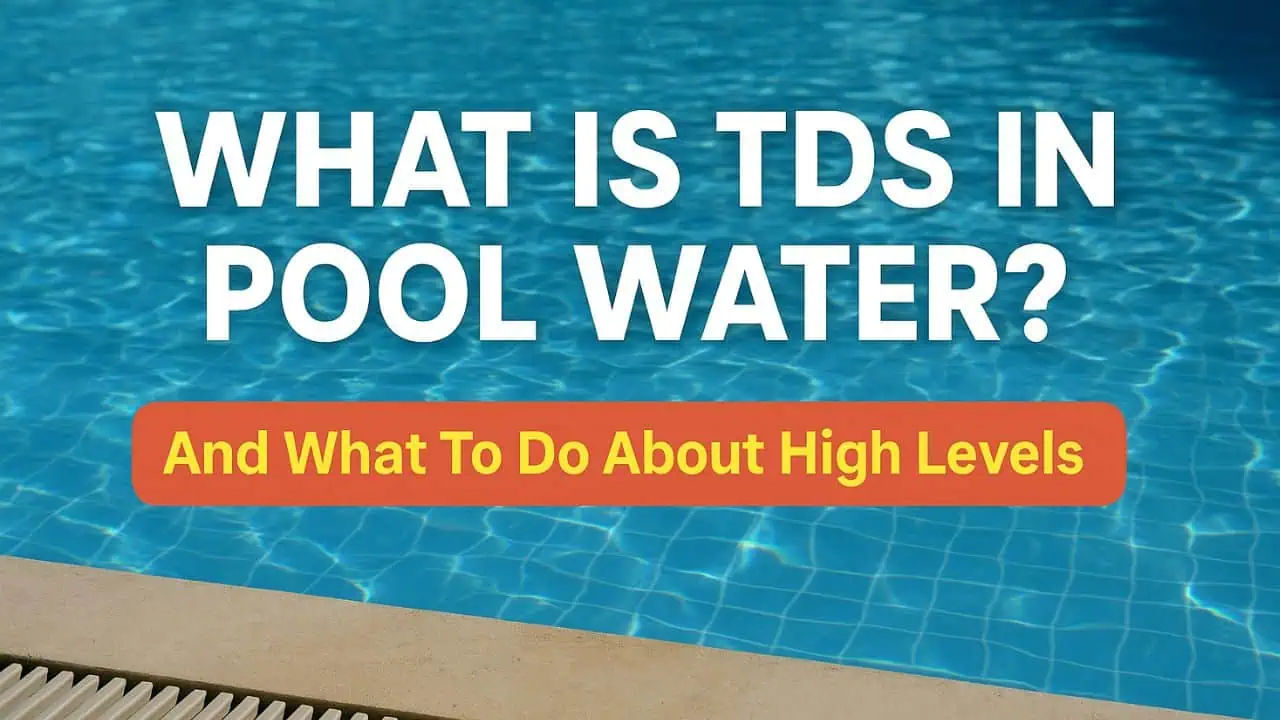
Leave a Reply